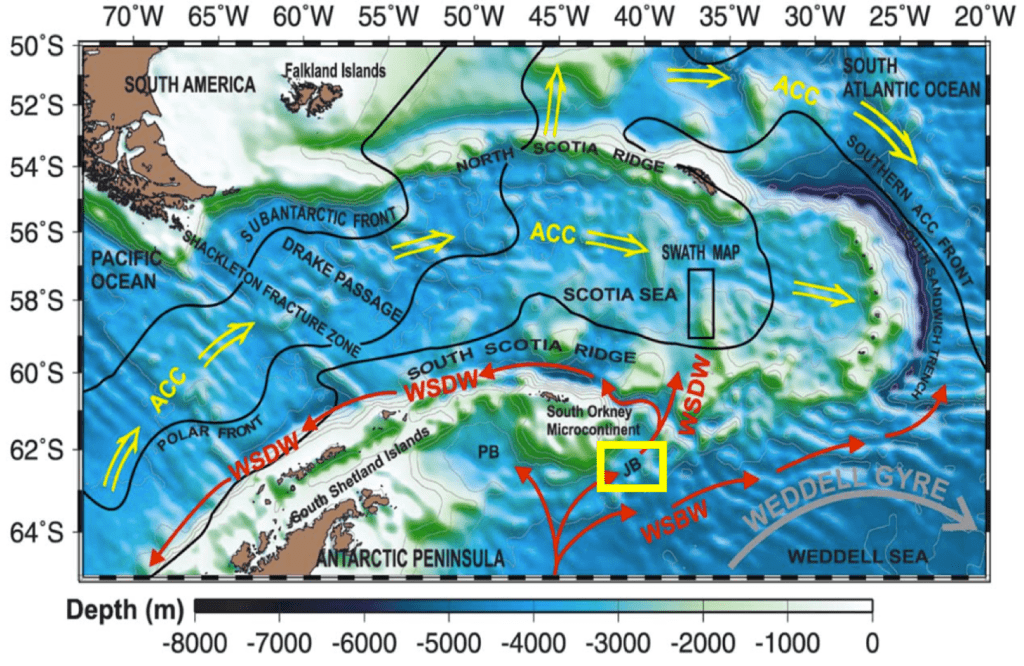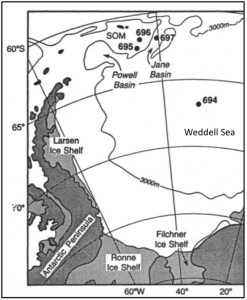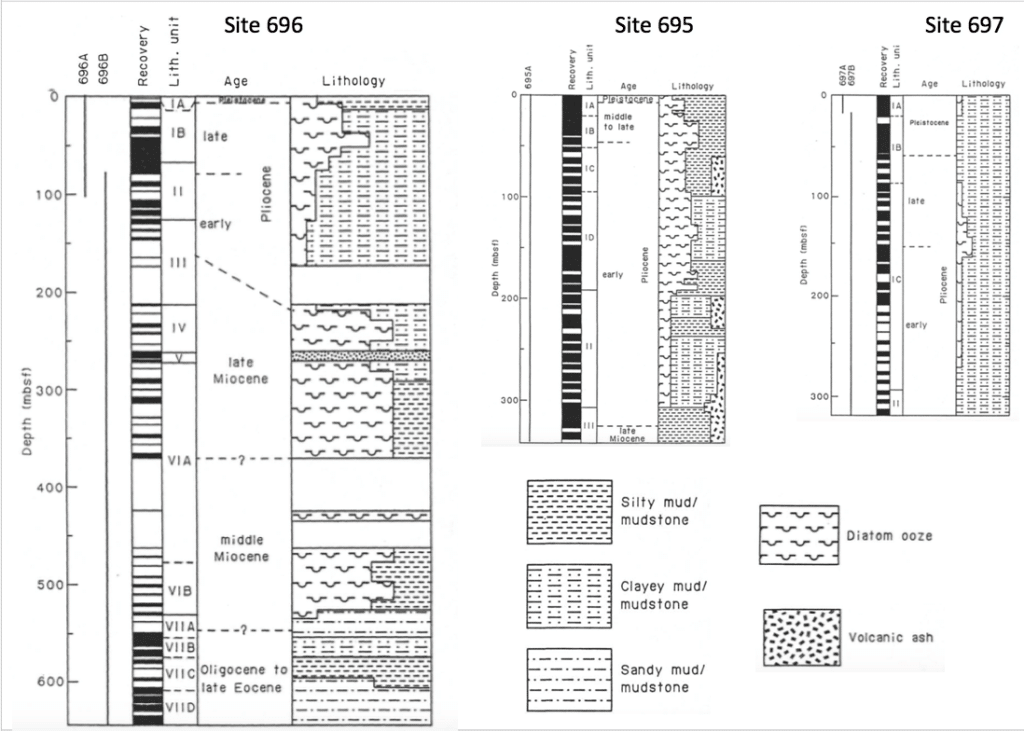What: Sea level rise is observed in many coastal areas from remote islands in the Pacific to naval bases in Richmond, VA. Critical to modeling and then adapting to this sea level rise is understanding how fast ice sheets are melting (water into the oceans) and oceans are warming (thermal expansion). The first five Intergovernmental Panel on Climate Change (IPCC) reports suggested < 1.5 m average rise by the end of the twenty-first century. Some (e.g. Instar, 2016, Oppenheimer and Alley, 2016) now consider a 1.5-2 m average rise* by the end of the 21st century a possibility. There are many reasons for this revision, but the largest change is in our understanding of Greenland (not discussed) and Antarctic Ice Sheet dynamics. Antarctica is separated by the Trans-Antarctic Mountains into West and East. In West Antarctica and the Antarctic Peninsula, the Pacific side of Antarctica substantial parts of the ice sheets are shelves that float in the ocean and are therefore particularly prone to disintegration and melting. In 2002, NASA (2002) recorded the collapse of the Larsen B Ice Shelf on West Antarctica. Since then ice streams have accelerated their flow into the Weddell Sea (Rignot et al., 2004). Looking back in time, Andrill drilling on the Ross Ice Shelf showed multiple Ross Ice Shelf collapses during the Pliocene (Andrill, 2009), when atmospheric CO2 levels where similar to today’s CO2 levels, about 400 ppm.
In contrast, in East Antarctica the majority of the ice rests on stable craton and thus was considered unlikely to contribute to sea level rise in the next few centuries, if not millennia. However, recent research suggests that this is not the case. East Antarctic ice sheets are more unstable and susceptible to melting than previously thought. Examination of International Ocean Discovery Program Drilling (IODP) cores from Wilkes Land and other areas of East Antarctica, also showed considerable and unpredicted Pliocene melting (e.g. Williams et al., 2010, Cook et al., 2014).
In this project we will look for evidence of ice sheet collapse and stability at three IODP Sites (695, 696, and 697) in the Jane Basin, south of the South Orkney Microcontinent. This area, also known as Ice Berg Alley, collects sediment from east and west Antarctica as currents and ice bergs exit the Weddell Sea and join the world’s oceans.
*NOTE; There’s no such condition as “average rise” Tamisiea and Mitrovica. 2011.
When: June 18- July 2 – College Station, TX (IODP/TAMU)
July 2- July 15 – Middletown, CT (Wesleyan)
Where: 2 weeks in College Station, TX (International Ocean Discovery Program); 2 weeks in Middletown, CT (Wesleyan University)
Who: 4 students and two mentors, Dr. Suzanne OConnell (Wesleyan University) and Dr. Joseph Ortiz (Kent State University) (Ortiz will participate in Middletown during the third week of the program.)

Figure 1. Modern bathymetric and oceanographic features of the northeastern Weddell and Scotia Seas. Solid red arrows show Weddell Sea Deep Water (WSDW), dense water above 4000m and Weddell Sea Bottom Water (WSBW), dense water deeper than 4000 m, exiting the Weddell Sea, joining Antarctic Circumpolar Current (ACC) and forming Antarctic Bottom Water (AABW). Yellow box (JB = Jane Basin) shows location of transect of ODP cores, PB = Powell Basin. (from Maldonado et al., 2003).
Project Overview: Students will spend the first two weeks of the project at the IODP core repository at Texas A&M University (TAMU) in College Station, TX. During the day they will prepare and measure split cores for non-destructive analyses (description, XRF, magnetic susceptibility, color imaging, spectrophometry). Students will be expected to learn the basis for and be able to describe at least two of the measurements. While at TAMU students will spend a day exploring opportunities for additional research and graduate school at the College of Geosciences (http://geosciences.tamu.edu/). The second two weeks (third and fourth) will be spent at Wesleyan University in CT.
During the third week, Dr. Joseph Ortiz (Kent State University) will teach students how to do statistical analyses on the data they collected. They will learn how to do principal component and wavelet analyses to interpret their data (e.g. Ortiz, 2011, Yurco et al., 2010). During the fourth week, these analyses will continue. In addition, students will prepare posters to share their findings at the 2017 Geological Society of America meeting in Seattle, WA. Students are encouraged to work with their advisors to find funds that will allow them to continue their research during the summer beyond the 4-week Keck program.
Potential student projects (These projects can be subdivided by site and by time interval (e.g. early/late Pliocene) depending upon sediment recovery, project focus and student’s plans for the academic year.)
-
What is the influence and expression of orbital cycles from the different sediment components (XRF, magnetic susceptibility, spectral reflectance, and color), from different depths and time intervals? What changes in mineralogy and sediment chemistry are creating the signal?
- Satellite data shows increased chlorophyll (higher productivity) around areas with large melting icebergs attributed to increased nutrient supply from melting ice (Duprat et al., 2016). In the sediment is there a correlation with increased IRD, wt. % biosilica in the <63um fraction, Total Organic Carbon (TOC) and C/N ratio?

Figure 4A. Location of three ODP sites to be studied, Sites 695, 696 and 697. SOM=South Orkney Microcontinent.

Figure 4C. Simplified sediment lithologies with sediment recovery and age (old Pliocene/Pleistocene boundary). (From Leg 113 Preliminary Report).
- Diatom identification. What species changes and preservation changes are observed during times of high and low diatom abundance? (e.g. Hambrey et al, 2003) Are different types of diatom species (e.g. ice dwelling, lower salinity, warmer water) found with higher abundances of coarse fraction (IRD). (We can help a student process the diatoms and prepare the slides, using the Harwood method (unpublished), but the student would need access to someone familiar with diatom identification.)
- Do changes in the mean sortable silt grain size indicate changes in the strength of Weddell Sea Deep Water, one of the precursors of AABW? In the North Atlantic (e.g. Hall and McCave, 2000) and Scotia Sea (Drake Passage, McCave et al., 2014) mean grain size in the sortable silt (10-63 um) size fraction increases with increased current speed. No one has measured sortable silt grain size on the < 63-micron fraction from all three ODP sites in the Jane Basin. With a depth transect, we will be able to compare current strength at three different depths. Of these the most important is Site 697, through which Weddell Sea Deep Water passes before joining the ACC and from there moves as AABW to the rest of the oceans. Preparing sediments for this grain size analysis is a long process, requiring, separating the coarse (>63 um fraction) and fine (<63 um fraction), drying the <63 um fraction, removing biosilica and then measuring the grain size. The student choosing this project will need access to a particle size analyzer. (Wesleyan does not own a particle size analyzer, but does have access to one at Central Connecticut State University.)
- How far can icebergs travel? What is the source area for the sediments based on ages of hornblende and biotite from the 150-500 um fraction (Williams et al., 2010) and/or the petrology of ice rafted rocks large enough to make a thin-section?
- Can glass shards be used to date paleoceanographic changes and/or provide a higher resolution age model for Jane Basin sediments? If sufficient numbers of glass shards are identified, geochemistry (composition and isotopic dating) may be able to indicate the source area and the age of the event.
Recommended Courses/Prerequisites: A positive answer to the question, do you want to provide information to the scientific community and modelers about ice sheet dynamics in a warming world?”
References and Background Reading:
Andrill, 2009. http://andrill.org/news/nature, accessed November, 2016
Anderson, R.F., Chasea, Z., Fleishera , M.Q., Sachs, J, 2002. The Southern Ocean’s biological pump during the Last Glacial Maximum Deep-Sea Research II, 49, 1909-1938.
Behrenfeld, M.J., Boss, E., Siegel, D.A., and Shea, D.M., 2004. Global Biogeochemical Cycles
2005, Carbon-based ocean productivity and phytoplankton physiology from space, v.19, GB1006, doi:10.1029/2004GB002299.
Church, J. A. et al. (too many authors to list) in Climate Change 2013: The Physical Science Basis (eds. Stocker, T. F. et al.) Ch. 13 (IPCC, Cambridge Univ. Press,). Chapter 13, Sea Level Change. (http://www.ipcc.ch/pdf/assessment-report/ar5/wg1/WG1AR5_Chapter13_FINAL.pdf)
Cope, N. (2009). “Reconstruction of a paleoclimate using Diffuse Spectral Reflectance.” [Undergraduate thesis]: Kent, Kent State University, 67 p.
Cook, C. P., Hill, D.J., van de Flierdt, T., Williams, T., Hemming, S.R., Dolan, A. M., Pierce, E.L., Escutia, C., Harwood, D., Cortese, G., and Gonzales, J.J. 2014. Sea surface temperature control on the distribution of far-traveled Southern Ocean ice-rafted detritus during the Pliocene, Paleoceanography, 29, 533-548, doi:10.1002/2014PA002625.
Duprat, L.P.A.M., Bigg, G. R. and Wilton, D.J. 2016. Enhanced Southern Ocean marine productivity due to fertilization by giant icebergs, Nature Geoscience, 9, 219–221. doi:10.1038/ngeo2633
Englert, H. 2015. Provenance of Weddell Sea dropstones: petrographic and geochemical evidence, http://keckgeo.com/wp-content/uploads/http:/www.keckgeology.org/28th-keck-symposium-volume/28thSymVol_Weddell_Englert.pdf
Hall, I.R. and McCave, I.N., 2000. Palaeocurrent reconstruction, sediment and thorium focusing on the Iberian margin over the last 140 ka. Earth Planet. Sci. Lett. 178, 151-164.
Hall, J. 2015. XRF derived cyclicity in Pliocene and Pleistocene sediments from ODP Site 693, Dronning Maud Land, Antarctica 7 pages, http://keckgeo.com/wp-content/uploads/http:/www.keckgeology.org/28th-keck-symposium-volume/28thSymVol_Weddell_Hall.pdf
Hambrey, M.J., Webb, P.-N., Harwood, D.M., and Krissek, L.A., 2003, Neogene glacial record from the Sirius Group of the Shackleton Glacier region, central Transantarctic Mountains, Antarctica, Geological Society of America Bulletin, 115, 994-1015.
Hansen, J., Sato, M., Hearty, P., Ruedy, R., Kelley, M., Masson-Delmotte, V., Russell, G., Tselioudis, G., Cao, J., Rignot, E., Velicogna, I., Kandiano, E. , von Schuckmann, K., Kharecha, P., Legrande , A. N., Bauer, M. and K.-W. Lo, K.W., 2015.
http://pmel.noaa.gov/co2/files/takahashi_flux.jpg, accessed November, 2016.
Instar, 2016. http://www.istar.ac.uk/wp-content/uploads/sites/5/sites/5/2016/05/West-Antarctica-Royal-Society-Meeting-Report-final.pdf
Jones, J., 2016 http://www.laboratoryequipment.com/news/2016/09/climate-change-jigsaw-puzzle-antarctic-pieces-missing?cmpid=horizontalcontent
Kaufman, Z.S., 2016. “Sediment Interpretations of Ice Rafted Debris in the Weddell Sea, Antarctica: a 3-3.8 Mya Record from ODP Site 697” (2016). Honors Theses Paper 1605.
http://wesscholar.wesleyan.edu/etd_hon_theses/1605
Lisecki L.E. and Raymo, M. 2005 A Pliocene-Pleistocene stack of 57 globally distributed 18O (o/oo) benthic records, 2005. Paleoceanography, 20, PA1003, doi:10.1029/2004PA001071
McCave, N., 2008. Chapter 8 Size Sorting During Transport and Deposition of Fine Sediments. Sortable Silt and Flow Speed in Developments in Sedimentology 60, 121-142. DOI: 10.1016/S0070-4571(08)10008-5
McCave, I. N., Crowhurst, S. J., Kuhn, G. , Hillenbrand, C-D. and Meredith, M. P. 2014. Minimal change in Antarctic Circumpolar Current flow speed between the last glacial and Holocene, Nat Geoscience, v. 7, 113-116. DOI: 10.1038/NGEO2037
McManus, J., Berelson, W.M., Klinkhammer, G.P., Johnson, K.S., Coale, K.H., Anderson, R.F., Kumar, N., Burdige, D.J., Hammond, D.E., Brumsack, H.J., McCorkle, D.C., and Rushdi, A., 1998. Geochemistry of barium in marine sediments: implications for its use as a paleoproxy, Geochim. Cosmochim. Acta., http://dx.doi.org/10.1016/S0016-7037(98)00248-8
Ma, Z., A. C. Ravelo, Z. Liu, L. Zhou, and A. Paytan (2015), Export production fluctuations in the eastern equatorial Pacific during the Pliocene-Pleistocene: Reconstruction using barite accumulation rates, Paleoceanography, 30, doi:10.1002/ 2015PA002860.
Maldonado, A., Barnolas, A., Bohoyo, F., Galindo-Zaldivar, J., Hernandez-Molina, J.,, Lobo, F., Rodriguez-Fernandez, J., Somoza, L., and Vazquez, J., 2003. Contourite deposits in the central Scotia Sea: the importance of the Antarctic Circumpolar Current and the Weddell Gyre flows, Paleo3, 198, 187-221.
Martinson, D. G., Pisias, N.G., Hays, J.D., Imbrie, J., Moore, T.C., Shackleton, N.J., 1987. Age dating and the orbital theory of the Ice Ages – development of a high-resolution 0 to 300,000-year chronostratigraphy. Quat. Res. 27, 1-29.
Mazaud, A., Michel, E., Dewilde, F. and Turon, J. L. 2010. Variations of the Antarctic Circumpolar Current intensity during the past 500 ka. Geochem. Geophys. Geosyst. 11, Q08007
NASA, 2002. http://earthobservatory.nasa.gov/Features/WorldOfChange/larsenb.php, accessed November, 2016
Oppenheimer, M. and Alley, R. B., 2016. How high will the seas rise? Science 354, 1375-1377. http://www.sciencemagazinedigital.org/sciencemagazine/16_december_2016?sub_id=BH2gDDZPjPIT&u1=09389598&folio=1375&pg=27#pg27
Ortiz, J.D., 2011, Application of Visible/near Infrared derivative spectroscopy to Arctic paleoceanography: IOP Conf. Series, Earth and Environmental Science, v. 14, no. 1, 012011, doi:10.1088/1755- 1315/14/1/012011.
Pagani, M., Liu, Z., LaRiviere, J., and Ravelo, A.C., 2010. High Earth-system climate sensitivity determined from Pliocene carbon dioxide concentrations, Nature Geoscience, v. 3, 27-30. DOI: 10.1038/NGEO724
Paytan, A., Kastner, M., Chavez, F.P., 1996. Glacial to Interglacial fluctuations in Productivity in the Equatorial Pacific as indicated by marine barite. Science, V. 274, 1355-1357.
Pierce, E.L., Hemming, S.R., Williams, T., van de Flierdt, T., Thomspon, P.W. Reiners, P.W., Gehrels, G.E, Brachfeld, S.A., Goldstein, S.L., A comparison of detrital U-Pb zircon, 40Ar/39Ar hornblende, biotite ages in marine sediment off East Antarctica: Implication for the geology of subglacial terrains and provenance studies. Earth-Science Reviews 138 (2014) 156–178, http://dx.doi.org/10.1016/j.earscirev.2014.08.010
Pliomax, http://sealevelstudy.org/, accessed 11/27/2016
Pudsey, C. J., Barker, P. R, and Hamilton, N., 1988. Weddell Sea abyssal sediments: a record of Antarctic Bottom Water flow. Marine Geology, 82:289-314.
Pudsey, C., 1990. Grain size and diatom content of hemipelagic sediments at Site 697, ODP Leg 113: A record of Pliocene-Pleistocene climate, in Barker, P. E, Kennett, J. P., et al., 1990 Proceedings of the Ocean Drilling Program, Scientific Results, Vol. 113, p. 111-120.
Pyle, K.M., Hendry, K.R.., Sherrell, R.M., Meredith, M.P., Venables, H., Lagerström, M.., and Morte-Ródenas, A. Coastal barium cycling at the West Antarctic Peninsula, Deep-Sea Research Part II, http://dx.doi.org/10.1016/j.dsr2.2016.11.010
Rignot, E., Casassa, G., Gogineni, P. , Krabill, W., Rivera, A., and Thomas, R. 2004. Accelerated ice discharge from the Antarctic Peninsula following the collapse of Larsen B ice shelf, Geophysical Research Letters, 31, doi:10.1029/2004GL020697
Rothwell, R.G. and Rack, F.R., 2006. New techniques in sediment core analysis: an introduction. In: Rothwell, R.G. (Ed.), New techniques in sediment core analysis. Special Publications. Geological Society, London, pp. 1–29.
Siriwardana, C. H. E. R. (2011). “Paleoclimatic Characterization of Arctic Ocean Sediments around the Northwind Ridge Using X-Ray Fluorescence and Visible-Near Infrared Spectroscopy.” [Masters thesis]: Kent, Kent State University, 96 p.
Spofforth, D.J.A., Pälike, H., Green, D., 2008. Paleogene record of elemental concentrations in sediments from the Arctic Ocean obtained by XRF analyses. Paleoceanography 23, PA1S09.
Tamisiea, M.E. and Mitrovica, J.X., 2011. The moving boundaries of sea level change: understanding the origins of geographic variability. Oceanography, 24 (2011), pp. 24–39
Thomson, J., Croudace, I.W., Rothwell, R.G., 2006. A geochemical application of the ITRAX scanner to a sediment core containing eastern Mediterranean sapropel units. In: Rothwell, R.G. (Ed.), New Techniques in Sedimentology
Yurco, L., Ortiz, J.D., Leonid Polyak, L., and Darby, D., 2010, Reflectance-based clay mineral cycles in Quaternary sediments from the Northwind Ridge: implications for glacial-interglacial sedimentation patterns in the Arctic Ocean, Polar Research, DOI: 10.1111/j.1751-8369.2010.00160.x.
Ziegler, M., Jilbert, T., de Lange, G.J., Lourens, L.J., Reichart, G.J., 2008. Bromine counts from XRF scanning as an estimate of the marine organic carbon content of sediment cores. Geochemistry, Geophysics, Geosystems 9, Q05009.



